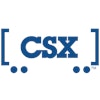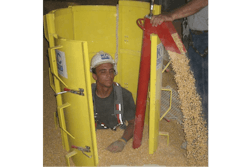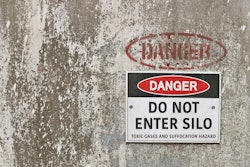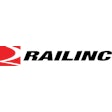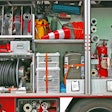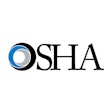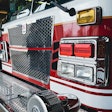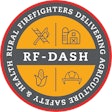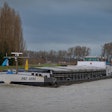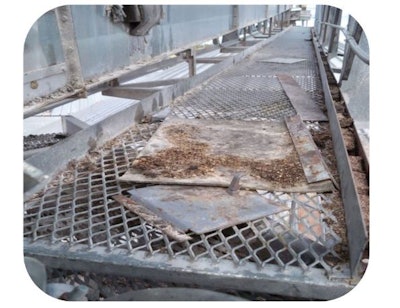
OSHA’s Walking Working Surfaces Standard is among the most frequently cited standards every year. Approximately 15% of accidental deaths are from slips, trips, and falls, according to OSHA data. And one-fifth of general industry’s workplace disabling injuries and days away injuries are the result of slips, trips and falls.
In order to reduce the statistics, in 2016 OSHA issued a new final rule for Walking-Working Surfaces and Personal Protective Equipment that updates and revises the general industry standards on slip, trip, and fall hazards.
The rule applies to all general industry workplaces — which grain and feed facilities fall under — and covers surfaces such as floors, scaffolds, stairs, ramps, roofs, ladders and elevated walkways.
The rule mandates training for fall protection systems and fall hazards. It also adds requirements to the design, performance and use of personal fall protection systems.
Some of the requirements are minor and include practices that many grain and feed facilities already employ. For example:
- Workplaces must be kept clean, orderly and sanitary
- Workroom floors must be as clean and dry as possible
- Employers must ensure each walking-working surface can support “maximum intended load” for surface
- Employers must provide and ensure employees use safe means of access and egress to and from walking-working surfaces
Requires inspection and maintenance of walking-working surfaces in safe condition
“OSHA’s expectations with the updated sub-part D is for employers to provide an atmosphere that is safe from known fall dangers and working surfaces that are free and clean of slip and trip hazards,” says Jim Seibert, director of safety, education and training for the National Grain and Feed Association. “It challenges the employers to engineer out falling hazards at their facilities.”
A provision that went into effect in November 2018 requires employers to ensure existing fixed ladders over 24 feet are equipped with a cage, well, personal fall arrest system or ladder safety system. Furthermore, permanent anchorages for rope descent systems are required to be inspected and certified by an engineer. Fortunately, the costliest provision of the ruling, which requires ladder safety or personal fall arrest systems installed on all fixed ladders over 24 feet, is only enforceable on new ladders and will not be enforced until 2036 for all ladders. While that may be a generous timeframe for companies to become compliant, some facilities have not yet completed provisions of the rule that were already required.
The rule also emphasizes training provisions, most of which went into effect in 2017.
By now, affected facilities should have trained all workers who use the equipment covered by the final rule on fall hazards.
Seibert suggests some immediate actions facility managers can take to head toward compliance with the new ruling.
Reaching compliance
The first steps toward compliance are eliminating any ladders that aren’t in compliance with the original rule and minimizing any unnecessary ladders on site, Seibert says.
“First I would take an inventory of [your facility’s] current situation,” he says. “You need to look at the ladders you have, document which ones are in compliance with the old standard, which of those ladders are used most often, and minimize the rest of the ladders in your facility. The ones that are out of compliance should be taken out of service.”
Seibert says facility managers should next focus on getting up-to-date on slip and fall hazard training for employees. If a facility is audited or inspected by OSHA today, the agency may ask to see documentation of training that took place prior to May 2017. The new ruling outlines the following Employer Training Requirements:
- Ensure workers who use fall protection and work in high hazard areas are trained and retrained (as needed) about fall hazards and equipment, and the proper use of FPSs.
- Trainer must be a qualified person and is responsible for training employees how to:
- Identify and minimize fall hazards
- Use personal fall protection systems and rope descent systems
- Maintain, inspect and store fall protection equipment or systems
Resources
The NGFA has developed three resources to help companies become compliant with the new ruling. All three can be found at ngfa.org/safety.
The NGFA Guidance Document for Compliance with OSHA Update to Subpart D was published in May 2018, in an effort with five NGFA members.
“We had input from senior members across the industry, people who have been involved in the Safety Health & Environmental Quality committee and regulatory safety at their facilities and companies,” Seibert says. “Together we took a very long document and condensed it down to four main focal points that would have the most direct effect on the agriculture industry: fixed ladders; stair ways; guard/hand/stair rails; and training requirements.”
Another resource NGFA developed is a FAQ document explaining the confusion between stair rails and hand rails as well as some of the wording in sub-part D. Seibert says the FAQ document includes direct answers from OSHA on specific questions addressing the use of the phrases ground level and lower level.
NGFA also provides the Articulate 360 Training Module: Slips, Trips and Falls, which includes video and audio to engage participants throughout the course. Users have the option to run the module from beginning to end, which takes about 50 minutes, or they can select specific modules to complete based on the time available. Certain points throughout the module allow instructors to pause the video and have the audience choose the best course of action for the situation.
Armed with these resources and educational materials, facility managers can gain the knowledge needed to become compliant with OSHA’s latest ruling on walking-working surfaces and fall protection systems — and ultimately help create safer workplaces for employees. ■
At-a-Glance: OSHA’s Major Changes
The updated final rule for OSHA’s Walking-Working Surfaces and Personal Protective Equipment includes some major changes from its former ruling. Jess McCluer, vice president of safety and regulatory affairs for the National Grain & Feed Association, compiled a list of the most significant changes.
- Cages and wells are no longer acceptable fall protection on fixed ladders higher than 24 feet
- Grandfather Provisions and Phase-In of New Provisions for Ladders that extend more than 24 feet above a lower level
- Employers must ensure that:
- Fixed ladder installed before Nov. 19, 2018, is equipped with personal fall arrest system, ladder safety system, cage or well
- Fixed laddersinstalled on or after Nov. 19, 2018, is equipped with personal fall arrest system or a ladder safety system
- When replacing a fixed ladder, cage or well (or any portion), personal fall arrest system or ladder safety system is installed
- On and after Nov. 18, 2036, all fixed ladders to be equipped with personal fall arrest system or ladder safety system
Visit ngfa.org/safety for more information, including an interactive course and the Guidance Document for Compliance with OSHA Update to Subpart D.


